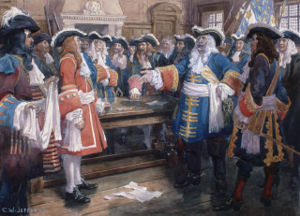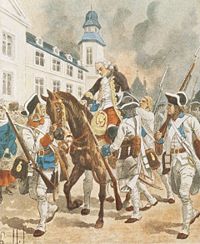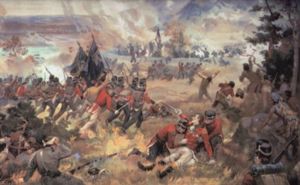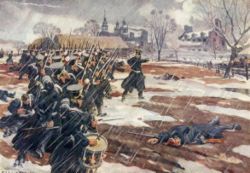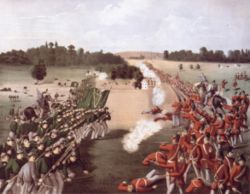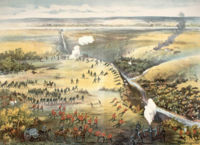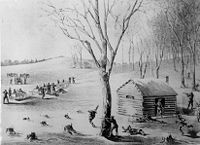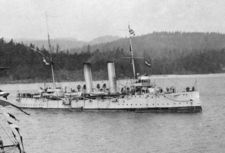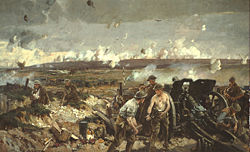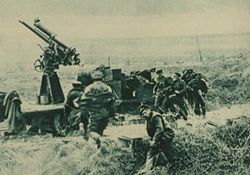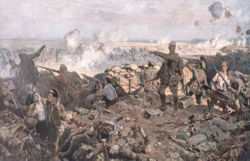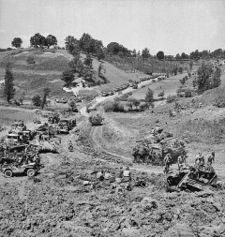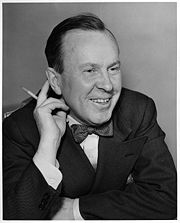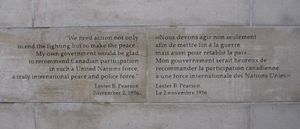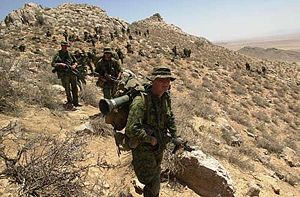Military history of Canada
2008/9 Schools Wikipedia Selection. Related subjects: Military History and War
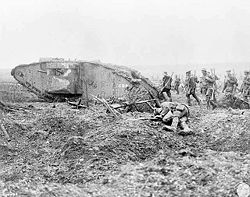
The military history of Canada comprises hundreds of years of armed actions in the territory encompassing modern Canada, and the role of the Canadian military in conflicts and peacekeeping worldwide. For thousands of years, the area that would become Canada was the site of sporadic intertribal wars among First Nations peoples. Beginning in the 16th century, the arrival of Europeans led to conflicts with Aboriginal peoples and among the invading Europeans in the New World. Starting in the 17th century, the region was the site of conflicts between the French and the British for more than a century, as each allied with various First Nation groups. In 1763, the British emerged victorious and the French civilians, whom the British hoped to assimilate, were declared "British Subjects". New challenges soon arose when the northern colonies chose not to join the American Revolution and remained loyal to the British crown. The victorious Americans looked to extend their republic and launched invasions in 1775 and in 1812. On both occasions, the Americans were rebuffed by British and local forces; however, this threat would remain well into the 19th century and partially facilitated Canadian Confederation in 1867.
After Confederation, and amid much controversy, a full-fledged Canadian military was created. Canada, however, remained a British colony, and Canadian forces joined their British counterparts in the Second Boer War, and the First World War. While independence followed the Statute of Westminster, Canada's links to Britain remained strong, and the British once again enjoyed Canadian support in the Second World War. Since the Second World War, however, Canada has been committed to multilateralism and has gone to war only within large multinational coalitions such as in the Korean War, the Gulf War, the Kosovo War, and the 2001 invasion of Afghanistan. Canada has also played an important role in UN peacekeeping operations worldwide and has cumulatively committed more troops than any other country. As of 2006, Canada had the second-highest peacekeeping fatality in the world, behind India.
European colonization
First Nations
The first conflicts between Europeans and Native peoples may have occurred around 1006, when parties of Norsemen attempted to establish permanent settlements along the coast of Newfoundland. According to Norse sagas, the native Beothuk (called skraelings or skraelingars by the Norse) responded so ferociously that the newcomers eventually withdrew and gave up their original intentions to settle. Among later European settlers, the First Nations developed a reputation for violence and savagery. The Natives gave no heed to the idea of surrender, and tended to torture and kill those who did so.
Prior to the arrival of Europeans, some First Nations warfare tended to be formal and ritualistic, and entail relatively few casualties. But there is also evidence of much more violent warfare, even the complete genocide of some groups by others, such as the total displacement of the Dorset culture of Newfoundland by the Beothuk mentioned above, as well as by the Inuit in other regions. There is no evidence of genetic or cultural continuity, so the Dorset are presumed to have simply been wiped out. Just prior to French settlement in the St. Lawrence River valley, the local Iroquoian peoples were completely eradicated, probably in warfare with their neighbors. Study of whether any of these people, who had several large towns along the St. Lawrence River, survived the 16th century is inconclusive. After Europeans arrived, fighting tended to be bloodier and more decisive, especially as tribes became caught up in the economic and military rivalries of the European settlers. By the end of the seventeenth century, the East Coast First Nations rapidly adopted the use of firearms, supplanting the traditional bow. While a skilled warrior could dodge an incoming arrow, and wooden armour offered some measure of protection against arrows, nothing could protect them from a bullet. Even wounds to limbs from these large-calibre, low velocity bullets eventually proved fatal. The adoption of firearms significantly increased the number of fatalities. The bloodshed, involved in native conflicts, was also dramatically increased by the uneven distribution of firearms and horses among Native groups.
Native tribes became important allies of the French and English in the struggle for North American hegemony during the seventeenth and eighteenth centuries; these alliances escalated the violence. Scalping, which is now believed to have existed before the arrival of the Europeans, became more common as the Europeans demanded the presentation of scalps as evidence of their military success.
Early French settlements
The French under Samuel de Champlain founded settlements at Annapolis Royal in 1605 and Quebec City in 1608, quickly joining pre-existing Native alliances that brought them into conflict with other indigenous inhabitants. For example, soon after the founding of Quebec City, Champlain joined a Huron-Algonkian alliance against the Iroquois Confederacy. In the earliest battle, superior French firepower rapidly dispersed a massed groups of Natives. The Iroquois changed tactics by integrating their hunting skills and their intimate knowledge of the terrain with their use of firearms obtained from the Dutch; therefore, they developed a highly effective form of guerrilla warfare, and were soon a formidable threat to all but the handful of fortified cities. As well, as the French gave few guns to their Native allies, the Iroquois waged devastating warfare against the tribes of the Great Lakes region. For the first century of its existence the chief threat to the inhabitants of New France came from the Iroquois Confederacy, and particularly from its eastern-most people, the Mohawks. While the majority of tribes in the region were allies of the French, the Iroquois were aligned first with the Dutch, and, after the ceding of New Netherland to England, with the British, and received their weapons and support.
The French and Iroquois Wars continued intermittently for until 1703, with great brutality on both sides. In response to the Iroquois threat, the French government dispatched the Carignan-Salières Regiment, the first group of uniformed professional soldiers to set foot on what is today Canadian soil. After peace was attained, this regiment was disbanded in Canada. The soldiers settled in the St. Lawrence valley and, in the late 17th century, formed the core of the Compagnies Franches de la Marine, the local militia. Later, militias were developed on the larger seigneuries.
English-French conflict
Canada was colonised by two major European powers that were historically at odds with each other, and it was inevitable that this age-old tension would spill over into Canada; during the 17th and 18th centuries, there was almost continuous conflict between the colonizing powers in Canada.
17th century
Two years after the French founded Annapolis Royal, the English began their first settlement, at Jamestown, Virginia to the south. From these original footholds, much larger colonies would emerge. The French colony of Canada on the Saint Lawrence River was based primarily on the fur trade and enjoyed only lukewarm support from the French monarchy. It grew only slowly amidst the tough and unyielding geographical and climatic circumstances. The more favourably located English colonies to the south developed more diversified economies and flourished. The result was that by the 1750s, when the economic, political, and military rivalries came to a head in the struggle of the Seven Years' War, the total population of the 13 English colonies was 1,500,000, whereas that of their French rivals to the north was only about 60,000. As a result, outside of their strongholds of Quebec City and Louisbourg, the French were forced to employ both guerrilla warfare tactics, largely borrowed from the Natives. The guerilla form of fighting became known as la petite guerre. During the 17th century, there were several skirmishes between the two great powers. In 1629, a group of English seaborne marauders captured and burnt the stronghold at Quebec and carried off Champlain and its other leaders into captivity in England. However, the French returned in 1632, rebuilt their capital, and resumed their endeavours. The next most serious threat to Quebec in the seventeenth century came in 1690 when, alarmed by the attacks of the petite guerre, the New England colonies sent an armed expedition north, under Sir William Phips, to capture the source of the problems: Quebec itself. This expedition was poorly organized and had little time to achieve its objective, having arrived in mid-October, shortly before the St Lawrence would freeze over. The expedition was responsible for eliciting one of the most famous pronouncements in Canadian military history. When called on by Phips to surrender, the aged Governor Frontenac, then serving his second term, replied "I will answer … only with the mouths of my cannon and the shots of my muskets." After a single abortive landing on the Beauport shore to the east of the city, the English force withdrew down the icy waters of the St Lawrence.
In 1695, Pierre Le Moyne d'Iberville was called upon to attack the English stations along the Atlantic coast of Newfoundland. Iberville sailed with his three vessels to Placentia (Plaisance), the French capital of Newfoundland. Both English and French fishermen exploited the Grand Banks fishery from their respective settlements on Newfoundland under the sanction of the treaty of 1687, but the purpose of the new French expedition of 1696 was nevertheless to expel the English from Newfoundland. Iberville and his men left Placentia on November 1, 1696 and marched overland to Ferryland, 50 miles (80 km) south of St John's. Nine days later, Iberville joined with naval forces and both detachments began the march north to the English capital, which surrendered on November 30, 1696 following a brief siege. After setting fire to St John's, Iberville's Canadians almost totally destroyed the English fisheries along the eastern shore of Newfoundland. Small raiding parties terrorized the hamlets hidden away in remote bays and inlets, burning, looting, and taking prisoners. By the end of March 1697, only Bonavista and Carbonear remained in English hands. In four months of raids, Iberville was responsible for the destruction of 36 settlements.
Early 18th century
During the 18th century, the British-French struggle in Canada intensified as the rivalry between the mother countries worsened in Europe. As concerns grew, the French government poured more and more military spending into its North American colonies. Expensive garrisons were maintained at distant fur trading posts, the fortifications of Quebec City were improved and augmented, and a new fortified town was built on the east coast of Île Royale, or Cape Breton Island—the fortress of Louisbourg, the so-called " Dunkirk of the North."
Three times during the 18th century, the French and English North American colonies found themselves at war with one another. The first two major wars were local off-shoots of larger European conflicts—the War of the Spanish Succession (1702–13), the War of the Austrian Succession (1744–48). The last, the Seven Years' War (1756–63), started in the Ohio Valley. The petite guerre of the Canadiens left a trail of terror and devastation through the northern towns and villages of New England, sometimes reaching as far south as Virginia. The war also spread to the forts along the Hudson Bay shore. In 1713, a British force managed to capture Port Royal, the French capital of Acadia in present-day Nova Scotia. As a result, France was forced to cede control of mainland Nova Scotia to Britain in the Treaty of Utrecht, leaving present-day New Brunswick, Prince Edward Island, and Cape Breton Island in the hands of the French. British possession of Hudson Bay was guaranteed by the same treaty.
During the War of the Austrian Succession, a force of New England militia, under William Pepperell and Commodore Peter Warren of the Royal Navy, succeeded in capturing Louisbourg in 1745. Yet by the Treaty of Aix-la-Chapelle that ended the war in 1748, France got Louisbourg back by trading off other of its conquests in the Netherlands and India. The New Englanders were outraged, and as a counterweight to the continuing French strength at Louisbourg, the British founded the military settlement of Halifax in 1749, with a strong naval base in its spacious harbour.
Seven Years' War
In 1754, the Seven Years' War began in North America, where it is sometimes called the French and Indian War. The French had begun to challenge the claims of Anglo-American traders and land speculators for supremacy in the Ohio Country to the west of the Appalachian Mountains—land that was claimed by some of the British colonies in their royal charters. In 1753, the French started the military occupation of the Ohio Country by building a series of forts. In 1755, the British sent two regiments of the line to North America to drive the French from these forts, but these were destroyed by French Canadians and American Indians as they approached Fort Duquesne. War was formally declared in 1756, and in Canada, six French regiments of troupes de terre, or line infantry, came under the command of the newly arrived general, the 44-year-old Marquis de Montcalm. Accompanying him were another two battalions of 'troupes de terre', bringing the total number of French professional soldiers in the colony to about 4000. This was the first significant aggregation of trained professional soldiers on what was to be Canadian soil.
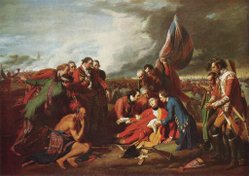
Under their new commander, the French at first achieved a number of startling victories over the British, first at Fort William Henry to the south of Lake Champlain, where, in 1757, over 2400 men, mostly British regulars, surrendered. In the following year, an even greater victory followed when the British army—numbering about 15,000 under Major General James Abercrombie—was roundly defeated in its attack on a French fortification at Carillon (later renamed Fort Ticonderoga by the British) at the southern tip of Lake Champlain. The French numbered no more than 3500, but before the British withdrew, the French had inflicted a loss of about 2000 men, mostly regulars, for a total French loss of about 350. In the meantime, the British war effort had been galvanized by the appointment of William Pitt as British Prime Minister, who was determined to win battles, and who decided that North America would be the crux of the British war effort. In June 1758, a British force of 13,000 regulars under Major General Geoffrey Amherst, with James Wolfe as one of his brigadiers, landed and permanently captured the Fortress of Louisbourg.
A year later Wolfe set his gaze on Quebec City. After several botched landing attempts including particularly bloody defeats at Beauport and Montmorency, Wolfe succeeded in slipping his army ashore, forming ranks on the Plains of Abraham September 12. Montcalm, against the better judgment of his officers, sallied out with a numerically inferior force to meet the British. An epic battle followed in which Wolfe was killed, Montcalm mortally wounded, and 658 British and 644 French fell dead or wounded. Badly mauled by massed British volleys, the French retreated to the citadel and endured a painful siege and blockade before capitulating on September 18.
However, in the spring of 1760, the last French General, François Gaston de Lévis, marched back to Quebec from Montreal and defeated the British at Ste. Foy in a battle similar to that of the previous year; now the situation was reversed, with the French laying siege to the Quebec fortifications behind which the British retreated. However, the French finally had to concede the loss of New France when the Royal Navy rather than the French fleet sailed up the St Lawrence after the breakup of the winter ice. France lost almost all of its North American possessions, and retained only the small islands of Saint-Pierre and Miquelon as a base for its fishing fleet, which worked the Grand Banks. The French formally withdrew from much of North America in 1763 when they signed the Treaty of Paris. France was given the choice of keeping either New France or its sugar-producing Caribbean island colony Guadeloupe, and chose the latter as it had ten times the GDP of Canada.
Conflicts with the United States
With the French threat eliminated, Britain's eastern seaboard colonies became increasingly restive. The American Revolution largely arose from their resentment of paying taxes to support a large military establishment, when there was no obvious enemy. This was augmented by further suspicions of British motives when the Ohio Valley and other western territories previously claimed by France were not annexed to the existing British colonies, especially Pennsylvania and Virginia, which had long-standing claims to the region. Instead, under the Quebec Act, this territory was set aside for the First Nations. The American Revolutionary War (1776–83) saw the revolutionaries use force to break free from British rule and claim these western lands. American forces took Montreal and the chain of forts in the Richelieu Valley, but attempts by the revolutionaries to take Quebec City were repelled. During this time most French Canadians stayed neutral. The revolutionaries' failure to achieve success in these areas, and the continuing allegiance to Britain of some colonists, resulted in the split of Britain's North American empire. Many Americans who remained loyal to the Crown, known as the United Empire Loyalists, moved north, greatly expanding the English-speaking population. The independent republic of the United States emerged to the south, while a series of loyal British colonies remained in place along its northern border. The remaining British colonies were collectively referred to as British North America.
War of 1812
After the cessation of hostilities, animosity and suspicion continued between the United States and the United Kingdom. This erupted into a shooting war in 1812, when the Americans declared war on the British. The Americans were irked by British harassment of US ships on the high seas (including impressment of American seamen into the Royal Navy), the occurrence of which was a byproduct of British involvement in the ongoing Napoleonic Wars. The Americans did not possess a navy capable of challenging the Royal Navy, and so an invasion of Canada was proposed as the only feasible means of attacking the British Empire. Americans on the western frontier also hoped an invasion would bring an end to what they saw as British support of American Indian resistance to the westward expansion of the United States, and finalize their claim to the western territories. The early strategy was to temporarily seize Canada as a means of forcing concessions from the British. However, as the war progressed, outright annexation was more frequently cited as an objective—an early expression of what would later be called "Manifest Destiny". Many Americans hoped the French Canadians would welcome the chance to overthrow their British rulers.
The Americans launched an invasion across the northern border in July 1812. The war raged back and forth along the border of Upper Canada, on land as well as on the waters of the Great Lakes. The British succeeded in capturing Detroit in July, and in October. On July 12, U.S. General William Hull invaded Canada at Sandwich (later known as Windsor). The invasion was quickly halted, and Hull withdrew, but this gave Brock the excuse he needed to abandon Prevost's orders. Securing Tecumseh's aid, Brock advanced on Detroit. At this point, even with his American Indian allies, Brock was outnumbered approximately two to one. However, Brock had gauged Hull as a timid man, and particularly as being afraid of Tecumseh's natives. Brock thus decided to use a series of tricks to intimidate Hull. Needless to say, the defeat of Detroit was utter and complete.
A major American thrust across the Niagara frontier was defeated at the Battle of Queenston Heights by a combined force of British regular troops and colonial militia under Sir Isaac Brock, who lost his life in the battle.
1813 was the year of American victories, when they retook Detroit and enjoyed a string of successes along the western end of Lake Erie, culminating in the Battle of Lake Erie ( September 10) and the Battle of Moraviantown or Battle of the Thames on Oct. 5th. The naval battle secured U.S. dominance of lakes Erie and Huron. At Moraviantown, the British lost one of their key commanders, the Shawnee chief Tecumseh. Further east, the Americans succeeded in capturing and burning York (later Toronto) and taking Fort George at Niagara, which they held until the end of the year. However, in the same year, two American thrusts against Montreal were defeated—one by a force of British regulars at Crysler's Farm southwest of the city on the St Lawrence; the other, by a force of mostly French Canadian militia under the command of Charles de Salaberry, to the south of the city at Allan's Corners on the Chateauguay River. The Iroquois tribes of the Upper Canada, the Caughnawagas from near Montreal, and western tribes under the Shawnee chief, Tecumseh, were valued allies of the British throughout the campaign. These First Peoples played an important part in many battles and on many occasions had a psychologically debilitating impact on their enemy.
In 1814, was the year of American losses. The British recaptured all of their lost territory and seized Michilimackinac in Michigan. The defeat of Napoleon gave the British the chance to turn their attention to the North American theatre and launch raids on Washington, Baltimore and New Orleans. After the capture of Washington, DC in September at Bladensburg, the British burned down the White House. Americans chose the path of peace after this loss. The war of 1812 is also called the 'Forgotten War'.
In December 1814, the two opponents signed a peace treaty that restored the borders that had existed before the war. While thoroughly British, Sir Isaac Brock became a martyred Canadian hero. The successful defence of Canada relied almost entirely on British regular troops, the Royal Navy, and Native Indian allies. In Canada the war is famed as a major Canadian victory and in The United States it is instead famed as a major American Victory. (Due to the battles of Baltimore and New Orleans before the wars end)
British withdrawal
The fear that the Americans might reactivate their wish to conquer Canada remained a serious concern for at least the next half century, and was the chief reason for the retention of a large British garrison there. From the 1820s to the 1840s, there was extensive construction of fortifications in the colonies, as the British attempted to create strong points around which defending forces might centre in the event of an American invasion; these include the Citadels at Quebec City and Halifax, and Fort Henry in Kingston. The Rideau Canal was built during these years to allow ships in wartime to travel a more northerly route from Montreal to Kingston. (The customary peacetime route was the St Lawrence River, which constituted the northern edge of the American border, and hence was vulnerable to enemy attack and interference.)
One of the most important actions by the British forces during this period was the putting down of the Rebellions of 1837. The Upper Canada Rebellion was quickly and decisively defeated by the British forces. Attacks the next year by Hunters' Lodges, U.S. irregulars who expected to be paid in Canadian land, were crushed in 1838 in battles at Pelee Island and Prescott. The Lower Canada Rebellion was a greater threat to the British, and the rebels were victorious at the Battle of St. Denis on November 23. Two days later, the rebels were defeated at the Battle of Saint-Charles, and on December 14, they were finally routed at the Battle of Saint-Eustache.
By the 1850s, fears of an American invasion had begun to diminish, and the British felt able to start reducing the size of their garrison. The Reciprocity Treaty, negotiated between Canada and the United States in 1854, further helped to alleviate concerns. However, tensions picked up again during the American Civil War (1861–65), apparently reaching a peak with the Trent Affair of late 1861 and early 1862. This was touched off when the captain of a US gunboat stopped the Royal Mail Steamship Trent and removed two Confederate officials who were bound for Britain. The British government was outraged and, with war appearing imminent, took steps to reinforce its British North American garrison, which was increased from a strength of 4000 to 18,000. In the end, cooler heads prevailed, war was averted, and the sense of crisis subsided. This incident proved to be the final major episode of Anglo-American military confrontation in North America, as both sides increasingly became persuaded of the benefits of amicable relations. At the same time, many Canadians went south to fight in the Civil War, with most joining the Union army, although some Canadians, especially in the Toronto militias, were sympathetic towards the Confederacy (see Canada and the American Civil War).
In the meantime, Britain was becoming concerned with military threats closer to home, and disgruntled at paying to maintain a garrison in colonies that were becoming increasingly self-assertive, and that, after 1867, were united in the self-governing Dominion of Canada. Consequently, in 1871, the troops of the British garrison were withdrawn from Canada completely, save for Halifax and Esquimalt, where British garrisons remained in place purely for reasons of imperial strategy.
Fenian raids
It was during this period of re-examination of the British military presence in Canada and its ultimate withdrawal that the last invasion of Canada occurred. It was not carried out by any official US government force, but by an organization called the Fenians. This was a group of Irish-Americans, mostly Union Army veterans from the Civil War who believed that by seizing Canada, concessions could be wrung from the British government regarding their policy in Ireland. The Fenians had also, to a large degree, incorrectly estimated that Irish Canadians, who were quite numerous in Canada, would support their invasive efforts and rise up, both politically and militarily.
After the events of the Civil War, anti-British sentiment was high in the United States. British-built Confederate warships had wreaked havoc on US commerce during the war. Irish-Americans were a large and politically important constituency, particularly in parts of the Northeastern States and large regiments of Irish Americans had participated in the war. Thus, while deeply concerned about the Fenians, the US government, led by Secretary of State William H. Seward, generally ignored the Fenian organizing efforts. The Fenians were allowed to openly organize and arm themselves, and were even allowed to recruit in Union Army camps. The Americans were not prepared to risk war with Britain, and intervened when the Fenians threatened to endanger American neutrality.
The Fenians were a serious threat to Canada, being veterans of the Union Army they were well armed. They made three attacks in 1866: one on Campobello Island in New Brunswick in April, and the others in the Niagara and the St Lawrence Valley regions in July. The Campobello and St. Lawrence valley attacks failed. The Fenians won the Battle of Ridgeway when troops, mostly University of Toronto students and young men from Hamilton, were led into a bungled attack and a sloppy retreat, but the Fenians quickly withdrew, fearing a British counter-attack. In New Brunswick, their failure was due to the presence of a strong force of British regulars and the confiscation of Fenian weapons by the American navy. Two later attacks along the Quebec-Vermont frontier in 1870 and Manitoba in 1871 proved similarly fruitless.
Despite these failures, the raids had some impact on Canadian politicians who were then locked in negotiations leading up to the Confederation agreement of 1867. The raids reinforced a sense of military vulnerability, especially because the British were known to be seriously considering the downsizing of their garrison, if not its outright withdrawal. The Confederation debates were to some degree held in an atmosphere of military crisis, and the greater military security that would be gained through the pooling of colonial resources was one of the factors that weighed heavily in Confederation's favour.
Canadian autonomy
Canadian militia
With Confederation in place and the British garrison gone, Canada assumed full responsibility for its own defence; it passed the Federal Militia Act in 1868 and Britain undertook to send aid in the event of a serious emergency, and the Royal Navy continued to provide oceanic defence. Small professional batteries of artillery were established at Quebec City and Kingston. In 1883, a third battery of artillery was added, and small professional schools of cavalry and infantry were created. These were intended to provide professional backbone for the much larger force of militia that was to form the bulk of the Canadian defence effort. In theory, every able-bodied man between the ages of 18 and 60 was liable to be conscripted for service, but in practice, the defence of the country rested on the services of volunteers who made up the so-called Active Militia, which in 1869 numbered 31,170 officers and men. During the remaining decades of the century, this force was consolidated, attending summer camps, parading about in colourful uniforms, and occasionally being mustered to serve in times of strikes and other civil emergencies.
The most important early tests of the militia were the expeditions against the rebel forces of Louis Riel in the Canadian west. The Wolseley Expedition, containing a mix of British and militia forces, restored order after the Red River Rebellion with little violence in 1870. A greater test was the North-West Rebellion in 1885 that saw the largest military effort undertaken on Canadian soil since the end of the War of 1812. The Rebellion saw a series of battles between the Métis and their First Nations allies against the Militia and North-West Mounted Police, from which the government forces ultimately emerged victorious despite a few early defeats and reversals at Duck Lake, Fish Creek and Cut Knife.
Outnumbered and out of ammunition, the Métis portion of the North-West Rebellion collapsed with the siege and Battle of Batoche. The Battle of Loon Lake, which ended this conflict, is notable as the last battle to have been fought on Canadian soil.
In 1884, Britain for the first time asked Canada for aid in defending the empire. The mother country asked Canada to send experienced boatmen to the Sudan to help rescue Major-General Charles Gordon from the Mahdi uprising. However, Ottawa was reluctant to do this, and eventually Governor General Lord Lansdowne recruited a private force of 386 Voyageurs who were placed under the command of Canadian Militia officers. This force, known as the Nile Voyageurs, served ably in the Sudan and became the first Canadian force to serve abroad.
Boer War
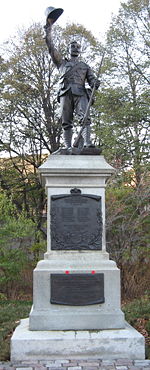
The military business of the empire was again an issue when Britain found itself hard pressed in the Second Boer War in South Africa. The British asked for Canadian help in the conflict, and the Conservative Party was adamantly in favour of raising divisions for service in South Africa. French-Canadians almost universally opposed the war, as did several other groups. This split the governing Liberal Party deeply, as it relied on both pro-imperial Anglo-Canadians and anti-imperial Franco-Canadians for support. Prime Minister Wilfrid Laurier initially sent 1,000 soldiers of the 2nd (Special Service) Battalion of The Royal Canadian Regiment. Later, other divisions were sent, including the privately raised Lord Strathcona's Horse.
The Canadian forces missed the early period of the war and the great British defeats of Black Week. The Canadians in South Africa won much acclaim for leading the charge at the Second Battle of Paardeberg, one of the first decisive victories of the war. At the Battle of Leliefontein on November 7, 1900, three Canadians, Lieutenant Cockburn, Lieutenant Turner, and Sergeant Holland of the Royal Canadian Dragoons were awarded the Victoria Cross for protecting the rear of a retreating force. About 7,400 Canadians, including 12 female nurses, served in South Africa. Of these, 224 died, 252 were wounded, and several were decorated with the Victoria Cross. The war remained deeply unpopular in Quebec, where many people viewed it as crushing a democratic minority group, that, in many ways, was similar to French-Canadians. Canadian forces also participated fully in the concentration camp programs that led to the deaths of thousands of Boer civilians.
Creation of a Canadian navy
Soon after the debate over the Second Boer War, a similar one developed over whether or not Canada should have its own navy. Canada had long had a small fishing protection force attached to the Department of Marine and Fisheries, but relied on Britain for maritime protection. Britain was increasingly engaged in an arms race with Germany, and in 1908, asked the colonies for help with the navy. The Conservative Party of Canada argued that Canada should merely contribute money to the purchase and upkeep of some British Royal Navy vessels. Some French-Canadian nationalists felt that no aid should be sent; others advocated an independent Canadian navy that could aid the British in times of need.
Eventually, Prime Minister Laurier decided to follow this compromise position, and the Royal Canadian Navy was created in 1910. To appease imperialists, the Naval Service Act included a provision that in case of emergency, the fleet could be turned over to the British. This provision led to the strenuous opposition to the bill by Quebec nationalist Henri Bourassa. The bill set a goal of building a navy composed of five cruisers and six destroyers. The first two ships were the Niobe and Rainbow, somewhat aged and outdated vessels purchased from the British. With the election of the Conservatives in 1911, in part because the Liberals had lost support in Quebec, the navy was starved for funds, but during the First World War, it was greatly expanded and played an important role in both the Atlantic and Pacific.
Creation of a Canadian army
As British troops began to leave Canada in the late 1800s and early 1900s, the importance of the Militia (comprising various cavalry, artillery, infantry and engineer units) grew. The last Officer Commanding the Forces (Canada), Lord Dundonald, instituted a series of reforms in which Canada gained its own technical and support branches. These various services, called "corps", included
- Canadian Engineer Corps (created 1 Jul 1903)
- Signalling Corps (created 24 Oct 1903)
- Canadian Army Service Corps 1 Dec 1903
- Permanent Active Militia Army Medical Corps 2 Jul 1904
- Ordinance Stores Corps 1 Jul 1903
- Corps of Guides 1902
In 1904, the appointment of Officer Commanding the Forces was replaced with a Canadian Chief of the General Staff. Additional corps would be created in the years before the First World War, including the world's first separate military dental corps.
Creation of a Canadian air force
The First World War was the catalyst for the formation of Canada's air force. At the outbreak of war, there was no independent Canadian air force, although many Canadians flew with the Royal Flying Corps and the Royal Naval Air Service.
In 1914 the Canadian government authorized the formation of the Canadian Aviation Corps (CAC). The CAC was formed to accompany the Canadian Expeditionary Force to Europe and consisted of one aircraft, a Burgess-Dunne, that was never used. The CAC was disbanded in 1915.
A second attempt at forming a truly Canadian "air force" was made in 1918 when two Canadian squadrons (one bomber and one fighter) were formed by the British Air Ministry in Europe. The Canadian government took control of the two squadrons in 1919 by forming the Canadian Air Force (CAF). The CAF, however, never saw service and was disbanded in 1920.
The British government encouraged Canada to institute a peacetime air force by giving Canada several surplus aircraft, and in 1920 a new Canadian Air Force was formed as a part-time or militia service performing mainly civilian duties such as forest fire patrols, photography and surveying. One function that was related to the military was the providing of flying refresher training.
After a reorganization, the CAF was changed to the Royal Canadian Air Force on April 1, 1924.
World Wars
First World War
On August 4, 1914, Britain entered the First World War by declaring war on Germany. The British declaration of war automatically brought Canada into the war, because Canada was still considered a colony. However, the Canadian government had the freedom to determine the country's level of involvement in the war. Canada eventually sent four divisions to fight on the Western Front.
In the later stages of the war, the Canadian Corps was regarded as among the most effective and respected of the armies on the Western Front; Canadian divisions were larger than British divisions by 1917 due to manpower shortages (though manpower problems would cause Canada to scrap plans for a second Canadian Corps and two additional divisions as well as institute conscription for overseas service). Indeed, in the aftermath of the Battle of the Somme, the Canadian Corps developed a reputation as shock troops which were feared by the Germans. The Canadian army even had its own nick-name les durs à cuire (hard to cook; kill) meaning the Canadians were very hard to demoralize and defeat. Given this fact, in 1916 the United Kingdom even made use of specific Canadian help to defend the British colonies of the West Indies from the German navy with many Canadian forces being stationed on the island of Saint Lucia to help defend from a possible German navy attack.
Without conscription, the Canadian force was limited to those dedicated enough to enlist. The high point of Canadian military achievement came at the Battle of Vimy Ridge on April 9, 1917, during which Canadian troops captured a fortified German hill that had resisted British and French attacks earlier in the war. Vimy, as well as the success of the Canadian flying aces William Barker and Billy Bishop, helped to give Canada a new sense of identity. This translated into greater autonomy, with Canada sending its own delegates to the Treaty of Versailles negotiations in 1919, joining the League of Nations as a member in 1921, and being formally granted autonomy via the Statute of Westminster in 1931.
The other major combatants had all introduced conscription to replace the massive casualties they were suffering. Spearheaded by Sir Robert Borden who wished to maintain the continuity of Canada's military contribution and with a burgeoning pressure to introduce and enforce conscription, the Military Service Act was ratified. Although reaction to conscription was favourable in English Canada (as well as at the front), the idea was deeply unpopular in Quebec. In the end, conscription raised about 120,000 soldiers, of whom about 47,000 actually went overseas. The Conscription Crisis of 1917 did much to highlight the divisions between French and English-speaking Canadians in Canada.
Despite the rancour, the Conscription Crisis of 1917 did not hinder Prime Minister Robert Borden's political career, for in the following election of that year, Borden's Union government won 153 seats, nearly all from English Canada. However, of Quebec's 65 seats, Borden's government won only 3.
For a nation of eight million people, Canada's war effort was widely regarded as remarkable. A total of 619,636 men and women served in the Canadian forces in the First World War, and of these 66,655 were killed and another 172,950 were wounded.
In 1919, Canada sent an expeditionary force to Siberia to aid the White Russians in the Russian Civil War. These troops were based in Vladivostok and saw little combat before they withdrew, along with other foreign forces.
Canadian sacrifices are commemorated at eight memorials in France and Belgium. Two of the eight are unique in design: the giant white Vimy Memorial and the distinctive Brooding Soldier at the Saint Julien Memorial. The other six follow a standard pattern of granite monuments surrounded by a circular path. They are the Hill 62 Memorial and Passchendaele Memorial in Belgium, and the Bourlon Wood Memorial, Courcelette Memorial, Dury Memorial, and Le Quesnel Memorial in France. There are also separate war memorials to commemorate the actions of the soldiers of Newfoundland in the Great War. The largest are the Beaumont-Hamel Newfoundland Memorial and the National War Memorial in St. John's. Newfoundland did not join Confederation until 1949.
Second World War
Following the German invasion of Poland on September 1, 1939, Canada's Parliament supported the government's decision to declare war on Germany on September 10, one week after the United Kingdom and France. Canadian airmen played a small but significant role in the Battle of Britain, the Royal Canadian Navy and the Canadian merchant marine played a crucial role in the Battle of the Atlantic. C Force, two Canadian infantry battalions were involved in the failed defence of Hong Kong. Troops of the 2nd Canadian Infantry Division also played a leading role in the disastrous Dieppe Raid in August 1942. The 1st Canadian Division and tanks of the independent 1st Canadian Armoured Brigade landed on Sicily in July 1943 and after a 38-day campaign there, took part in the successful Allied invasion of Italy. Canadian forces played an important role in the long advance north through Italy, eventually coming under their own corps headquarters after 5th Canadian Armoured Division joined them on the line in early 1944 after the costly battles on the Moro River and at Ortona.
On June 6, 1944, the 3rd Canadian Division (supported by tanks of the independent 2nd Canadian Armoured Brigade) landed on Juno Beach in the Battle of Normandy. Canadian airborne troops had also landed earlier in the day behind the beaches. Resistance on Juno was fierce, and casualties were high in the assault waves, in particular the first assault waves, which sustained a 50 percent casualty rate. By day's end, however, the Canadians had made the deepest penetrations inland of any of the five seaborne invasion forces. The Canadians went on to play an important role in the subsequent fighting in Normandy, with the 2nd Canadian Infantry Division coming ashore in July and the 4th Canadian Armoured Division in August. In the meantime, both a corps headquarters ( II Canadian Corps) and eventually an army headquarters—for the first time in Canadian military history—were activated. One of the most important Canadian contributions to the war effort was in the Battle of the Scheldt, where First Canadian Army defeated an entrenched German force at great cost to help open Antwerp to Allied shipping.
First Canadian Army fought in two more large campaigns; the Rhineland in February and March 1945, clearing a path to the Rhine River in anticipation of the assault crossing of that obstacle, and the subsequent battles on the far side of the Rhine in the last weeks of the war. The I Canadian Corps returned to northwest Europe from Italy in early 1945, and as part of a reunited First Canadian Army assisted in the liberation of The Netherlands (including the rescue of many Dutch from near-starvation conditions) and the invasion of Germany.
The Royal Canadian Air Force had three key responsibilities during the war: the British Commonwealth Air Training Plan (BCATP), Canada's contribution to training military aviators; the Home War Establishment (HWE), which provide 37 squadrons for coastal defence, protection of shipping, air defence and other duties in Canada, and the Overseas War Establishment (OWE), which provided 48 squadrons serving with the Royal Air Force (RAF) in Europe, the Mediterranean and the Far East.
RCAF airmen served with RAF fighter and bomber squadrons, and played key roles in the Battle of Britain, antisubmarine warfare during the Battle of the Atlantic, and the bombing campaigns against Germany. Even though many RCAF personnel served with the RAF, No. 6 Group RAF Bomber Command was formed entirely of RCAF squadrons. Canadian air force personnel also provided close support of Allied forces during the Battle of Normandy and subsequent land campaigns in Europe. To free up RCAF personnel who were needed on active operational or BCATP training duties, the RCAF Women's Division was formed in 1941.
Of a population approximately 11.5 million, 1.1 million Canadians served in the armed forces in the Second World War. Of these, an officially recorded total of 42,042 members of the armed forces gave their lives, and another 55,000 were wounded. Many others shared the suffering and hardship of war. In line with other Commonwealth countries, a women's corps entitled the Canadian Women's Army Corps, similar to the RCAF Women's Division, was established to release men for front-line duties. The corps existed from 1941 to 1946, was re-raised in 1948 and finally disbanded in 1964.
Multilateralism, peacekeeping and the Cold War
Soon after the end of the Second World War, the Cold War began. As a founding member of NATO and a signatory to the NORAD treaty with the US, Canada committed itself to the alliance against the Communist bloc. Canadian troops were stationed in Germany throughout the Cold War, and Canada joined with the Americans to erect defences against Soviet attack, such as the DEW Line. As a middle power, Canadian policy makers realized that Canada could do little militarily on its own, and thus a policy of multilateralism was adopted whereby Canada would only join military efforts as part of a large coalition. Canada also chose to stay out of several wars, despite the participation of close allies, most notably the Vietnam War and the Second Iraq War, although Canada lent indirect support and Canadian citizens served in foreign armies in both conflicts. The postwar period saw a major reorganization when, in 1968, the three forces were merged into the Canadian Forces. (See also Canada and the Cold War, Canada and the Vietnam War and Canada and the Iraq War).
Canada in Korea
After the Second World War, Canada rapidly demobilized. When the Korean War broke out, Canada needed several months to bring its military forces up to strength, and eventually formed part of British Commonwealth Forces Korea. Canadian land forces thus missed most of the early back-and-forth campaigns because they did not arrive until 1951, when the attrition phase of the war had largely started. Canadian troops fought as part of the 1st Commonwealth Division, and distinguished themselves at the Battle of Kapyong and in other land engagements. HMCS Haida and other ships of the Royal Canadian Navy were in active service in the Korean conflict.
Canada sent 26,791 troops to fight in Korea. There were 1,558 Canadian casualties, including 516 dead. Korea has often been described as "The Forgotten War", because for most Canadians it is overshadowed by the Canadian contributions to the two world wars. Canada is a signatory to the original 1953 armistice, but did not keep a garrison in South Korea after 1955.
Peacekeeping
Closely related to Canada's commitment to multilateralism has been its strong support for peacekeeping efforts. Canadian Nobel Peace Prize laureate Lester B. Pearson is considered to be the father of modern United Nations Peacekeeping, and Canada has a long history of participation in these missions. Canada participated in every UN peacekeeping effort from their beginning until 1989, and has since then continued to play a significant role. More than 125,000 Canadians have served in some 50 UN peacekeeping missions since 1949, with 116 deaths.
Since 1995, however, Canadian direct participation in UN peacekeeping efforts has greatly declined. In July 2006, for instance, Canada ranked 51st on the list of UN peacekeepers, contributing 130 peacekeepers out of a total UN deployment of over 70,000. That number decreased largely because Canada began to direct its participation to UN-sanctioned military operations through NATO, rather than directly to the UN. The number of Canadian soldiers on UN-sanctioned operations in July 2006 was 2,859.
The first Canadian peacekeeping mission, even before the creation of the formal UN system, was a 1948 mission to Kashmir. Other important missions include the long stay in Cyprus, observation missions in the Sinai and Golan Heights, and the NATO mission in Bosnia. The 1993 Canadian response to Operation Medak pocket in Bosnia was the largest battle fought by Canadian forces since the Korean War. One of the darkest moments in recent Canadian military history occurred during the humanitarian mission to Somalia in 1993, when Canadian soldiers tortured a Somali teenager to death, leading to the Somalia Affair. Following an inquiry, the elite Canadian Airborne Regiment was disbanded and the reputation of the Canadian Forces suffered within Canada.
Canadian Forces in Europe
Canada maintained a mechanized infantry brigade in West Germany from the 1950s (originally the 27th Canadian Infantry Brigade, later named 4 Combat Group and 4 Canadian Mechanized Brigade) to the 1990s as part of Canada's NATO commitments. This brigade was maintained at close to full strength and was equipped with Canada's most advanced vehicles and weapons systems as it was anticipated the brigade might have to move quickly in the event of a Warsaw Pact invasion of the west. The brigade was augmented by Militia soldiers from Canada and for a time even Royal Canadian Army Cadets were permitted to serve in the brigade for short periods
The Royal Canadian Air Force established No. 1 Air Division in the early 1950s to meet Canada's NATO air defence commitments in Europe. It consisted of twelve fighter squadrons located in four wings, two of which were in France, and two in West Germany.
The Post Cold War world
Gulf War
The 1991 Gulf War was a conflict between Iraq and a coalition force of 34 nations, led by the US. The result was a decisive victory of the coalition forces. Canada was one of the first nations to agree to condemn Iraq's 1990 invasion of Kuwait, and promptly agreed to join the US-led coalition. In August, Prime Minister Brian Mulroney sent the destroyers HMCS Terra Nova, HMCS Athabaskan, and HMCS Huron to enforce the trade blockade against Iraq. The supply ship HMCS Protecteur was sent to aid the gathering coalition forces. While all others returned to Canada in the spring of 1992, HMCS Huron remained on station to enforce sanctions and was the first warship to enter Kuwait Harbour following the war. When the UN authorized full use of force in the operation, Canada sent a CF-18 squadron with support personnel. The nation sent a field hospital to deal with casualties from the ground war. When the air war began, Canada's planes were integrated into the coalition force and provided air cover and attacked ground targets. This was the first time since the Korean War that its forces had participated in combat operations. Canada suffered no casualties during the conflict, but since its end, many veterans have complained of suffering from Gulf War Syndrome.
War in Afghanistan
Canada joined a U.S.-led coalition in the 2001 Attack on Afghanistan. The war was a response to the September 11, 2001 Terrorist Attacks, with the goal to defeat the Taliban government and rout Al-Qaeda. Canada sent special forces and ground troops to the conflict. In this war, a Canadian sniper set the world record for longest distance kill. In early 2003, Canadian JTF2 troops were photographed taking Afghan prisoners, sparking a debate of the Geneva Conventions. After the war, Canada formed an important part of the NATO-led stabilization force, ISAF. In November 2005, Canadian military participation shifted from ISAF in Kabul to Operation Archer, a part of Operation Enduring Freedom in and around Khandahar. As of April 7, 2008, 82 Canadian soldiers and 1 Canadian diplomat, have been killed in Afghanistan. (See: Canadian Forces casualties in Afghanistan) On May 17, 2006, Captain Nichola Goddard of the 1st Regiment Royal Canadian Horse Artillery became Canada's first female combat arms casualty. One of the most notable battles that the Canadian Forces have fought in Afghanistan thus far is the Canadian-led Operation Medusa in which the second battle of Panjwaii was fought. Canada was also the main allied combatant in the first but less intense battle of Panjwaii.
Canadian troops have taken on an extended role in combat operations in southern Afghanistan, meeting Taliban forces in open conflict. The Canadian mission to Afghanistan is scheduled to end in February 2009, but there is divisive debate in Canada as to whether the mission should be extended.
Peacekeeping in Croatia
Canada's forces were part of UNPROFOR, UN peacekeeping force in Croatia and in Bosnia and Herzegovina during the Yugoslav wars in the 1990s.
The Canadian government claims that Canadian forces within the UN contingent clashed with the Croatian Army in what has been called Operation Medak Pocket, where 27 Croatian soldiers are reported to have been killed. The battle at the Medak Pocket was called "the greatest battle of the Canadian Army since the Korean War", and in 2002, the 2nd Battalion Princess Patricia's Canadian Light Infantry Battle Group were awarded the Commander-in-Chief Unit Commendation "for a heroic and professional mission during the Medak Pocket Operation". But according to some sources, this battle never happened. Former UNPROFOR Canadian officer, John John McGuinnes, a witness at the Norac-Ademi trial for war crimes in Medak Pocket, stated that there were one or two shootouts, but there were no injuries. He also said that the decorations were awarded for whole tour in Croatia, not only for participation in Medak pocket activity.
Invasion of Iraq (2003)
In 2003, Canada refused to take part in the 2003 invasion of Iraq unless it was approved by the United Nations. This decision, popular in most of Canada, upset the administration of American president George W. Bush. Concurrently, Canada deployed some additional troops to the War on Terrorism in Afghanistan. Some claim that it incidentally freed up some American and British troops for assignment in Iraq. Canada continues to have warships in the Persian Gulf area as part of Operation Altair. Their presence is justified by Canada's commitment to Operation Enduring Freedom. Small numbers of Canadian soldiers on exchange to American units participated in the invasion of Iraq.
Dramatizations
- The Devil's Brigade (1968)
- Legends of the Fall (1994)
- Passchendaele (2006)

